These are the former and current buildings and structures of Towson University and its predecessor institutions.[1]
Former locations
These buildings are located in Baltimore, Maryland. The School/College/University was housed in them at separate periods before the institution moved to its current suburban location, north of the City of Baltimore in north-central Baltimore County in the county seat of Towson, Maryland in September 1915.
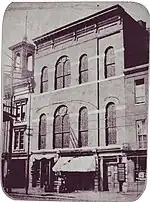 "Red Men's Hall", North Paca Street
"Red Men's Hall", North Paca Street
1866 William Howard Mansion/Union Club/Athenaeum Club
William Howard Mansion/Union Club/Athenaeum Club
1872 Lafayette Square - Carrollton and Lafayette Avenues
Lafayette Square - Carrollton and Lafayette Avenues
1875
Former buildings
Academic and administrative
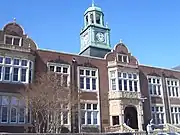 Stephens Hall
Stephens Hall
1915
College of Business and Economics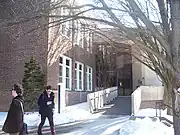 Van Bokkelen Hall
Van Bokkelen Hall
1924
Mass Communication and Communication Studies
Communication Sciences and Disorders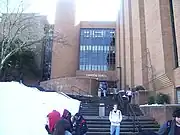 Smith Hall
Smith Hall
1965
Biology and Sciences Building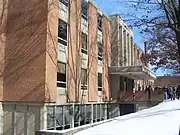 Linthicum Hall
Linthicum Hall
1968
College of Liberal Arts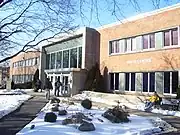 Media Center
Media Center
Former Library
Department of Mass Communication and Communication Studies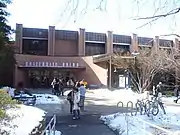 University Union
University Union
1972
Auxiliary Office
University Store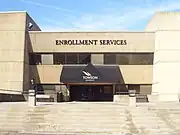 Enrollment Services
Enrollment Services
Former Administration Building
1972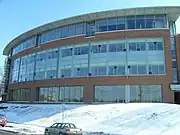 Center for the Arts
Center for the Arts
1973
College of Fine Arts & Communication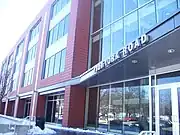 7800 York Road
7800 York Road
2003
Department of Computer and Information Sciences, Math Department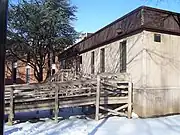 Stephens Hall Annex
Stephens Hall Annex
Communication Offices
Army ROTC
Now Demolished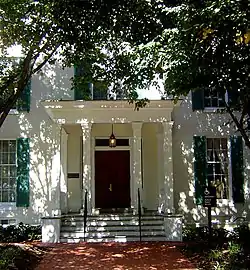
Non-academic
 "Glen Esk" Counseling Center
"Glen Esk" Counseling Center
Now demolished Power Plant
Power Plant
1915 Dowell Hall
Dowell Hall
Health Facility
1962
Now demolished Burdick Hall
Burdick Hall
Gymnasium, Weight Room, Sports Facility
1967
Residence buildings
 Newell Hall
Newell Hall
1915 Richmond Hall
Richmond Hall
1924 West Hall
West Hall
1951 Ward Hall
Ward Hall
1951 Prettyman Hall
Prettyman Hall
1957 Scarborough Hall
Scarborough Hall
1964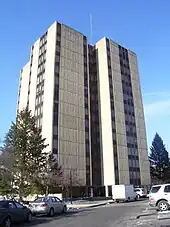 Residence Tower
Residence Tower
1972 Glen Complex
Glen Complex
1983 Towson Run Apartments
Towson Run Apartments
1989 Millennium Hall
Millennium Hall
2000 The Residences at 10 West Burke Avenue
The Residences at 10 West Burke Avenue
Dining halls and facilities
 Newell Dining Hall
Newell Dining Hall
Newell Den Glen Dining Hall
Glen Dining Hall PAWS
PAWS TRAX
TRAX Susquehanna
Susquehanna
Campus landmarks
 Clocks on the Psychology Building
Clocks on the Psychology Building Burke Avenue Bridge
Burke Avenue Bridge Glen Bridge
Glen Bridge
History
Administration Hall (now Stephens Hall), Newell Hall, and the Power Plant were the first three original buildings built on the suburban Baltimore County campus in 1913–1915, which opened September 1915, facing York Road.
In 1936, the Works Progress Administration (W.P.A.), part of Roosevelt's "New Deal" program, had spent over $55,000 in its work on "The Glen". It included lodges which were used for open air classes and meetings, a council ring for ceremonies, and an amphitheater.
The original Lida Lee Tall building was renamed Van Bokkelen Hall in 1960, after the man and Episcopal priest, Libertus Van Bokkelen, who was authorized by the new third Maryland Constitution of 1864 and first served as Maryland State Superintendent of Public Instruction, in 1865, heading the developing, supervision and advising of public school systems for the various counties and funded the new Maryland State Normal School (M.S.N.S.).
After the school was moved to Towson in 1914–1915, Richmond became the first principal to live in the white, colonial style house "Glen Esk" (now near Prettyman Hall). This was the residence of one of the estates existing on the land facing York Road, south of old Towsontown that was secured for the school. However, in 1970, President James Fisher became the last to live in the "Glen Esk" house since the school moved to Towson. Because it was no longer suitable for a family, as students were occasionally found passed out on the lawn, it was eventually turned into the Counseling Center.
In 1971, as Earle T. Hawkins, former president of Towson State University, researched the school's history, he became especially interested in the meaning of the name of the house, "Glen Esk", now the counseling center. Hawkins published an article in The Baltimore Sun, in which he suggested he was trying to solve this mystery. In response, he received a letter from the wine and spirits importers Maynard and Child, Inc. of Scotland, who included a label from their brand of whiskey called "Glen Esk."
The Cook Library occupies space that was once a gymnasium. Prior to its opening, the current Media Center served as the Library.
George LaTour Smith, (whom Smith Hall is named after), died on his way home after getting hit by a locomotive. The administration felt that it was respectful to name the building in his honor.
Notable people
- J. Charles Linthicum, of Linthicum, Maryland in Anne Arundel County, a graduate who served in the U.S. House of Representatives and pushed the bill to make the "Star Spangled Banner" the national anthem in March 1931.
- Dr. M. Bates Stephens, former Maryland State Superintendent.
- Libertus Van Bokkelen, first head of Maryland State School system, founded the Normal School.
- George L. Smith, the first head of the science department at the Normal School.
- Albert S. Cook, former Maryland State Superintendent for 21 years.
- Anita S. Dowell, a former faculty member and former Dean of the college, was largely responsible for the health instruction program of the college structured in 1953.
- Dr. Donald Minnegan served over 45 years at Towson, and was the only men's physical education faculty member for many of those years. Hawkins thought it would be fitting for the future field house to be named for him.
Presidents/Principals with buildings named after them
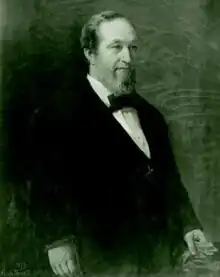 McFadden Alexander Newell
McFadden Alexander Newell
First Principal, Maryland State Normal School (MSNS), 1866–1890.jpg.webp) E. Barrett Prettyman (1830–1907)
E. Barrett Prettyman (1830–1907)
Principal, MSNS, 1890–1905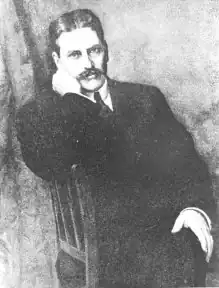 George W. Ward (1867–1932)
George W. Ward (1867–1932)
Principal, MSNS, 1905–1909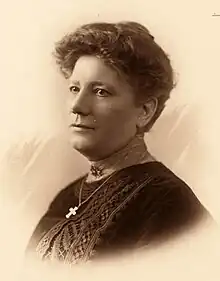 Sarah E. Richmond (1843–1921)
Sarah E. Richmond (1843–1921)
Principal, MSNS, 1909–1917
References
- ↑ Bridge, James (April 2002). "Renovations build on history of University". The Towerlight. Archived from the original on 2007-09-27. Retrieved 2007-09-04.